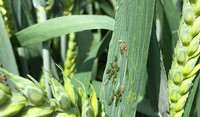
T1: the key timing for wheat disease control

As part of an Integrated Pest Management (IPM) programme, the most effective way to control foliar diseases is to implement a preventative fungicide strategy which will keep crops ahead of infections. This is best achieved by applying a diverse range of fungicide modes of action, with a multi-site such as ARIZONA (500 g/l folpet) included at T1 to add an extra layer of early season disease control. Including folpet at this timing can deliver a significant yield improvement, with recent trials showing that a single application of ARIZONA at T1 will more than pay for itself by giving an average yield uplift of 0.26 t/ha.
In high-risk wheat situations (for example where a susceptible variety was drilled early) folpet can also be applied at T0 and/or T2. Two applications of folpet have been proven to increase the yield response to as much as 0.6t/ha when used alongside older or weaker azole/SDHI mixtures and by a more modest but still respectable 0.2 to 0.25 t/ha when used in conjunction with newer single site actives such as Revysol and Inatreq.
Future-proofing septoria control
As well as the economic and yield benefit effects of using folpet at T1, it’s multi-site mode of action also play an important part in managing resistance. Repeatedly using single site fungicides (azoles, SDHIs and strobilurins) can increase the rate at which disease resistance to these active ingredients develops. However, the inclusion of folpet (which is less prone to resistance due to its ability to work against multiple metabolic processes within the target pathogen) can counter the reduction in sensitivity to single sites, with modelling studies carried out by Rothamsted Research predicting that mixing a triazole with folpet can double the former’s effective life.
More recent modelling work carried out by ADAS has also predicted that folpet can double the effective life of fluxapyroxad and that mixing folpet with field rates of fluxapyroxad delivers improved disease control.
Folpet is therefore recognised by the Fungicide Resistance Action Group (FRAG) as a valuable tool for managing resistance thanks to its ability not only to provide added levels of disease control, but also to protect and prolong the lifespan of medium to high resistance risk fungicides like SDHIs. For more information visit The Fungicide Resistance Action Group (FRAG-UK) website.
ARIZONA® – Powered by MSI Protech
ARIZONA® (500 g/L folpet) is the ideal multi-site fungicide for septoria control: its ability to control septoria and deliver a positive yield response makes it a very cost-effective addition to T1 applications. It also provides the added benefits of extending the effective life of partner products and not interfering with the curative kickback activity of partner azoles or SDHIs.


